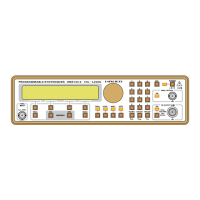9
Subject to change without notice
Getting started
After depressing the power (red) key (1), the HM8134 display
will successively contain the following messages:
• the type (SYNTHESIZER) and the reference
of the instrument (HM8134)
• the self-test messages «RAM checking» and «DDS
loading»
• the reference frequency in progress
(internal or external)
• the type of interface ( HO88 / HO89 / HO90 )
• IEEE488 address if the option is present.
The unit takes again the previous configuration existing before
switching off . The output signal is always off.
Factory configuration
At delivery the instrument is adjusted for a basic set-up as
follows:
• Frequency: 1000MHz
• Level: +7dBm
• No modulation
• Internal reference frequency
• Fmod: 1kHz, Shape: sine (for all modulations)
• Dev: 20kHz (FM), Dev: 1rad (PM) , Depth: 50% (AM)
• Backlight medium, contrast maximum.
• Sound indicator: none.
• Rotary control: on.
• If HO90 default config (4800 bauds / 1 stop / 8 bits)
This basic adjustment can be recalled at any time as follows:
• Switch off the unit.
• Switch on the unit and hold the «ESC» key until hearing
several «beeps».
This procedure is specially useful in case of doubt.
Caution:
The 10 memories storing configurations are erased and
replaced by the previous basic adjustments.
Main display
This display shows the frequency and level of the RF output
signal and the reference in use (INT or EXT) too. We get, if no
modulation (AM, FM, PM) is turned on:
Moreover, it contains some modulation parameters (for
example in case of AM modulation , shape SQR and Fmod =
1kHz)
We leave this state by pressing one of the function (9) or one
of the four context sensitive keys (5).
«Escape» key (13)
The «ESC» key allows the user to be back in the main display,
unselecting the current function (9) or cancelling the numeric
keypad input.
Setting parameters
Once a parameter is selected (for exemple «FREQ.») with a
function key (9) , a new value of this parameter can be entered
from the data keypad (11) or modified by the digital rotary (10)
or by one of the four context sensitive keys below the
displayed marks - and + (for appling step) (5).
Operation of the data keypad is conventional. Depress
successively the numeric keys representing the parameter
value and at the end depress the unit key ( for example MHz
or dBm ...). Note that it is not necessary to enter any trailing
zeroes.
Before the unit selection , it is possible to cancel the value by
pressing the «ESC» key (13) , the previous value is restored.
The choice of the units is free but the instrument will display
the properest unit ( for example 1 to 3 digits on the left of the
decimal point ).
The encoder modifies the value of the digit underlined by the
cursor (even if the cursor underlines a blank position which is
considered as 0). The cursor move to another position by
pressing the keys (5) below < and > and the value can be
increased or decreased by - and +.
An unproper value is announced by a warning message
(except for the out of range encoder and steps) and the sound
indicator.
Selecting frequency
After pressing the «FREQ» function key (9),we get:
A new value of this carrier can be entered from the data keypad
(11) or modified by the digital rotary (10) or one of the four
context sensitive keys (5). For more details, refer to the
paragraph « setting parameters».
The frequency range is: 1Hz to 1024MHz.
The resolution is 1Hz, if a value is entered with a higher
resolution the instrument makes a truncation keeping 1Hz
resolution.
Selecting level
After pressing the «LEVEL» function key (9), we get:
Operation - Getting started

